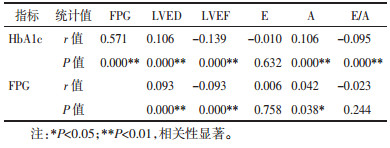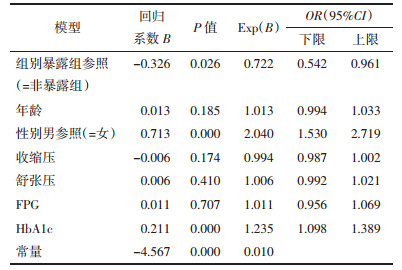文章信息
- 周颖, 黄梦楠, 刘昳佳, 于春泉
- ZHOU Ying, HUANG Mengnan, LIU Yijia, YU Chunquan
- 中成药联合西药治疗冠心病心绞痛患者在不同空腹血糖水平下糖化血红蛋白与心功能的相关性分析
- The correlation analysis of Chinese patent medicine combined with western medicine treatment on coronary heart disease between glycation hemoglobin and heart function in patients with coronary angina at different glucose levels
- 天津中医药, 2021, 38(11): 1372-1377
- Tianjin Journal of Traditional Chinese Medicine, 2021, 38(11): 1372-1377
- http://dx.doi.org/10.11656/j.issn.1672-1519.2021.11.04
-
文章历史
- 收稿日期: 2021-09-26
2. 天津中医药大学, 天津 301617
随着中国人口老龄化和生活方式的改变,冠心病和糖尿病的发病率逐年升高。20世纪90年代由Stern提出的“共同土壤”学说,认为冠心病与2型糖尿病之间因其基因和代谢水平可能存在共同的发病基础[1]。空腹血糖(FPG)和糖化血红蛋白(HbA1c)升高会显著增加心血管疾病(CVD)的发生风险[2]。冠心病作为中成药治疗的优势病种,在中医属“胸痹心痛”范畴,中成药可按其证型分类进行联合治疗以改善患者的临床症状。本研究采用回顾性队列研究方法旨在探讨冠心病心绞痛患者FPG、HbA1c与心功能之间的相关性,分析中成药联合西药治疗对冠心病心绞痛患者在不同FPG水平下HbA1c及心功能相关指标的影响。
1 材料与方法 1.1 研究对象本研究采用回顾性队列研究方法,通过医院病案管理系统收集2014年9月—2019年9月在天津市6家医院(天津中医药大学第一附属医院、天津中医药大学第二附属医院、天津市南开医院、天津市胸科医院、天津医科大学总医院、天津中医药研究院附属医院)就诊的107 301例冠心病心绞痛住院患者的病历资料,选取其中具有FPG、HbA1c与彩色多普勒超声心动图检查指标的2 959例患者作为研究对象。
1.2 诊断标准冠心病心绞痛诊断标准参照美国心脏病学会和心脏协会(ACC/AHA),中华医学会心血管病学分会和中国中医药研究促进会中西医结合心血管病预防与康复专业委员会制定的相关指南[3-7]。
冠心病稳定型心绞痛符合以下任何1项或多项即可诊断:1)有明确的陈旧性心肌梗死病史。2)曾行冠状动脉造影或冠状动脉计算机断层扫描(CT)血管造影(CTA)检查提示冠状动脉至少1支主要分支管腔直径狭窄≥50%。3)接受冠状动脉血运重建[经皮介入支架植入术(PCI)或冠状动脉旁路移植术(CABG)]治疗后心电图ST段压低或T波倒置者。
冠心病不稳定性心绞痛包括如下亚型:1)静息性心绞痛:心绞痛发作在休息时,并且持续时间通常在20 min以上。2)初发心绞痛:1个月内新发心绞痛,可表现为自发性发作与劳力性发作并存,疼痛分级在Ⅲ级以上。3)恶化劳力型心绞痛:既往有心绞痛病史,近1个月内心绞痛恶化加重,发作次数频繁、时间延长或痛域降低(心绞痛分级至少增加Ⅰ级,或至少达到Ⅲ级)。4)变异性心绞痛:通常是自发性。其特点是一过性ST段抬高,多数自行缓解,不演变为心肌梗死,但少数可演变成心肌梗死。动脉硬化斑块导致局部内皮功能紊乱和冠状动脉痉挛是其发病原因,硝酸甘油和钙离子拮抗剂可以使其缓解。
1.3 纳入及排除标准 1.3.1 纳入标准1)年龄在35~75岁之间,性别不限。2)入院时间为2014年9月1日——2019年9月1日。3)冠心病心绞痛诊断符合西医诊断标准。4)符合使用药物治疗标准的患者,暴露组使用中成药联合西药常规治疗,非暴露组单独使用西医常规治疗。
1.3.2 排除标准1)合并其他心脏疾病、神经官能症、更年期综合征、甲状腺功能亢进、脊髓型或椎动脉型颈椎病、胃-食管返流病或食道裂孔疝等可能引起胸痛的疾病。2)患有急性心肌梗死、心功能四级、心肌炎、心肌病、严重心脏瓣膜病变,肝功能衰竭或肾功能衰竭、恶性肿瘤以及严重代谢性疾病等重大疾病者以及症状严重、无法控制的心绞痛患者。3)孕妇、哺乳期妇女或有生育要求的育龄妇女。4)精神病患者,或认知功能障碍。5)活动性感染,炎症性疾病,血液系统疾病和/或恶性肿瘤以及慢性肾脏和肝脏疾病的患者。6)研究者认为存在不适合参加该试验的其他情况。
1.4 伦理学审查本课题已通过天津中医药大学伦理委员会审查,伦理审查批件号为TJUTCM-EC20190008。
1.5 临床注册本课题分别在Clinical Trials.gov(注册号为NCT04026724)及中国临床试验注册中心(注册号为ChiCTR1900024535)注册,注册单位系天津中医药大学。
1.6 数据采集与录入方法采用Epidata 3.1软件研究建立相关数据库,采用双人双机独立录入数据。利用软件中Checks功能进行比较后得出相应报告,根据此报告与原始数据比对,确保录入数据与原始数据的一致性,将数据录入误差控制在1%之内。
1.7 观察指标收集患者的一般资料包括年龄、性别、收缩压、舒张压、既往史及家族史等。患者入院当天禁食8 h后次日晨起抽取静脉血,检测血常规、FPG、血脂、HbA1c、肝功能、肾功能等生化指标。住院期间进行彩色多普勒超声心动图检查,测量左室舒张末期前后径(LVED)、左心室射血分数(LVEF)、二尖瓣流速E(E)、二尖瓣流速A(A),计算二尖瓣流速E/二尖瓣流速A(E/A)。
观察FPG、HbA1c、LVED、LVEF、E、A、E/A在暴露组和非暴露组两组间是否具有统计学差异;根据FPG四分位分组,观察各组间HbA1c、LVED、LVEF及E/A的差异性;观察FPG、HbA1c与LVED、LVEF及E/A之间是否具有相关性。
1.8 统计学方法应用SPSS 24.0软件进行统计分析,计量资料符合正态分布用均数±标准差(x±s)表示,组间比较采用t检验,不符合正态分布或方差不齐时用中位数(下四分位数、上四分位数)[M(Q25,Q75)]表示,组间比较使用非参数检验Wilcoxon符号秩检验进行;计数资料用频数及百分比表示,组间比较采用χ2检验;采用Spearman相关性分析FPG、HbA1c与LVED、LVEF及E/A之间是否具有相关性。以左心室收缩功能异常(LVEF<55%)发生率(是/否)为因变量,将患者是否服用中成药、性别、年龄、HbA1c、FPG作为自变量进行二元Logistic回归分析。P < 0.05为差异具有统计学意义。
2 结果 2.1 一般资料根据纳入、排除标准共收集冠心病心绞痛患者2 959例,其中暴露组1 576例、非暴露组1 383例。
采用倾向性评分匹配(PSM)分析一般资料。匹配前,除病程在暴露组与非暴露组之间分布平衡外,其他资料在两组间的分布均不平衡,差异具有统计学意义(P < 0.01)。将暴露组作为基准组进行PSM后,共有1 254对匹配成功。匹配后,除病程外,其他各项资料在暴露组和非暴露组之间的分布平衡,差异无统计学意义(P > 0.05)。见表 1。
通过对两组患者FPG、HbA1c结果进行统计,经正态性检验,两组患者的FPG、HbA1c均不符合正态分布,故采用Mann-Whitney U检验。结果显示,与非暴露组相比,暴露组FPG、HbA1c水平明显降低,差异有统计学意义(P < 0.05或P < 0.01)。见表 2。

|
通过对两组患者心功能各项指标结果进行统计,经正态性检验,两组患者的LVED、LVEF、E、A、E/A均不符合正态分布,故采用Mann-Whitney U检验。结果显示,其中LVED、LVEF、E/A在两组间差异无统计学意义(P > 0.05),E、A在两组间差异有统计学意义(P < 0.05)。见表 3。

|
将暴露组和非暴露组两组患者按照空腹血糖四分位法进行分组,比较在不同FPG水平下两组患者心功能指标和HbA1c的水平。
FPG分组标准:Q1(FPG≤5.16 mmol/L)、Q2(5.16 mmol/L < FPG≤5.97 mmol/L)、Q3(5.97 mmol/L < FPG≤7.53 mmol/L)、Q4(FPG > 7.53 mmol/L)。
如表 4-7所示,FPG分组后比较HbA1c,在暴露组和非暴露组间均无统计学差异(P > 0.05)。FPG分组Q1、Q2的心功能各项指标,在暴露组和非暴露组间均无统计学差异(P > 0.05);Q3中LVEF、Q4中LVED、LVEF、E在暴露组和非暴露组间差异有统计学意义(P < 0.05),余指标差异无统计学意义(P > 0.05)。

|

|

|

|
将2 508例冠心病心绞痛患者FPG、HbA1c与心功能指标LVED、LVEF、E、A、E/A进行Spearman相关性分析。分析结果显示HbA1c、FPG、LVED、A两两之间均呈正相关性(P < 0.05),HbA1c、FPG与LVEF均呈负相关性(P < 0.05),HbA1c与E/A呈显著负相关性(P < 0.01)。见表 8。

|
以左心室收缩功能异常(LVEF<55%)发生率(是/否)为因变量,将患者是否服用中成药、性别、年龄、HbA1c、FPG作为自变量进行二元Logistic回归分析,结果显示,经拟合优度检验,模型符合原始数据分布(P > 0.05),预测左心室收缩功能异常的发生率与是否服用中成药、性别、HbA1c有关,与其他因素无关。左心室收缩功能异常的发生率与是否服用中成药呈负相关,与性别、HbA1c呈显著正相关。说明服用中成药联合西药治疗冠心病心绞痛可以降低患者左心室收缩功能异常的发生率,男性和高HbA1c患者的左心室收缩功能异常的发生率相对较高。见表 9。

|
中成药在冠心病心绞痛防治中的应用广泛,对于改善患者临床症状确有疗效[8-9]。现代药理研究表明,如通脉养心丸调控冠心病稳定性心绞痛气阴两虚证的生化基础与内皮损伤、脂质代谢、炎症因子有关[10];麝香保心丸具有保护血管内皮、抑制血管炎症反应、促进血管新生、减轻心脏炎症反应、抑制心肌纤维化,改善大鼠心血管功能等的功效[11]。
如今糖尿病被明确认为是心血管疾病的独立危险因素,糖尿病患者常并发肥胖、高血压病、血脂异常等心血管疾病,其发生心血管疾病的风险增加2~4倍[12]。许多国内外研究表明血糖升高与心血管事件的发生密切相关[13-14],高血糖状态会导致氧化应激反应、扩大炎症反应、加重血管内皮功能受损,促进凝血功能亢进,对心肌细胞产生直接毒性等损伤心功能[15]。高血糖时与血红蛋白结合形成HbA1c,HbA1c反映患者在采血前8~12周的平均血糖水平,是血糖水平控制的金标准[16]。
本研究结果显示中成药联合西药治疗冠心病心绞痛可以有效降低患者的FPG、HbA1c水平,但短期内对于心功能的改善并无显著效果。在不同FPG水平下,在较低FPG水平组,中成药联合西药治疗对于改善糖代谢水平和心功能的意义不大,高FPG(> 7.53 mmol/L)水平组,中成药联合西药治疗对于心功能指标LVED、LVEF的改善明显。经Spearman相关性分析显示,FPG、HbA1c与心功能指标LVED、LVEFA之间均呈正相关性,HbA1c、FPG与LVEF均呈负相关性,HbA1c与E/A呈显著负相关性。说明可以通过FPG、HbA1c来大致评估冠心病心绞痛患者的心功能水平,控制患者的FPG、HbA1c水平对于其心功能有积极意义。经二元Logistic回归分析预测左心室收缩功能异常的发生率与是否服用中成药、性别、HbA1c有关,与其他因素无关。以上结果可推测治疗冠心病心绞痛类中成药对患者左心室收缩功能异常的发生率FPG、HbA1c水平有降低作用,因高血糖与心血管的强相关性,当血糖处于较高水平对心血管系统造成一定损伤时,中成药联合西药治疗的效果会更加显著。
本研究为依据LVEF可大致判断左心室整体的收缩功能状态,而仅凭E/A无法明确判断左心室舒张功能,需要参考其他心超参数和患者的年龄及临床症状。加之中成药对于心功能的改善在短时间内不明显,还需进一步开展相关前瞻性研究为中成药联合西药治疗冠心病心绞痛改善糖代谢水平和心功能指标提供相关依据。
| [1] |
JIN Z, PU L, SUN L. Identification of susceptibility variants in ADIPOR1 gene associated with type 2 diabetes, coronary artery disease and the comorbidity of type 2 diabetes and coronary artery disease[J]. Plos One, 2014, 9(6): e100339. DOI:10.1371/journal.pone.0100339 |
| [2] |
中华医学会糖尿病学分会. 中国2型糖尿病防治指南(2020年版)[J]. 中华糖尿病杂志, 2021, 13(4): 315-409. Chinese Diabetes Society. Guideline for the prevention and treatment of type 2 diabetes mellitus in China (2020 edition)[J]. Chinese Journal of Diabetes Mellitus, 2021, 13(4): 315-409. |
| [3] |
FRAKER T D, FIHN S D, GIBBONS R J, et al. 2007 chronic angina focused update of the ACC/AHA 2002 guidelines for the management of patients with chronic stable angina[J]. Journal of the American College of Cardiology, 2007, 50(23): 2264-2274. DOI:10.1016/j.jacc.2007.08.002 |
| [4] |
WRIGHT R S, ANDERSON J L, ADAMS C D, et al. 2011 ACCF/AHA focused update of the guidelines for the management of patients with unstable angina/non-ST-elevation myocardial infarction (updating the 2007 guideline) a report of the American college of cardiology foundation/American heart association task force on practice guidelines developed in collaboration with the American college of emergency physicians, society for cardiovascular angiography and interventions, and society of thoracic surgeons[J]. Journal of the American College of Cardiology, 2011, 57(19): 1920-1959. DOI:10.1016/j.jacc.2011.02.009 |
| [5] |
中华医学会心血管病学分会, 中华心血管病杂志编辑委员会. 慢性稳定性心绞痛诊断与治疗指南[J]. 中华心血管病杂志, 2007, 35(3): 195-206. Chinese Society of Cardiology of Chinese Medical Association, Editorial Board of Chinese Journal of Cardiology. Guideline for diagnosis and treatment of patients with chronic stable angina[J]. Chinese Journal of Cardiology, 2007, 35(3): 195-206. DOI:10.3760/j.issn:0253-3758.2007.03.002 |
| [6] |
中华医学会心血管病学分会介入心脏病学组, 中华医学会心血管病学分会动脉粥样硬化与冠心病学组, 中国医师协会心血管内科医师分会血栓防治专业委员会, 等. 稳定性冠心病诊断与治疗指南[J]. 中华心血管病杂志, 2018, 46(9): 680-694. Chinese Society of Cardiology of Chinese Medical Association interventional cardiology group, Chinese Society of Cardiology of Chinese Medical Association atherosclerosis and coronary heart disease group, Professional Committee of Thrombosis Prevention and Treatment of Cardiovascular Physicians Branch of Chinese Medical Doctor Association, et al. Guidelines for the diagnosis and treatment of stable coronary heart disease[J]. Chinese Journal of Cardiology, 2018, 46(9): 680-694. DOI:10.3760/cma.j.issn.0253-3758.2018.09.004 |
| [7] |
中国中医药研究促进会中西医结合心血管病预防与康复专业委员会. 稳定性冠心病中西医结合康复治疗专家共识[J]. 中西医结合心脑血管病杂志, 2019, 17(3): 321-329. Cardiovascular Disease Prevention and Rehabilitation Professional Committee of China Association for the Promotion of Chinese Medicine Research. Experts consensus on the rehabilitation treatment of integrative medicine for stable coronary heart disease[J]. Chinese Journal of Integrative Medicine on Cardio-Cerebrovascular Disease, 2019, 17(3): 321-329. |
| [8] |
季昭晨, 胡海殷, 杨丰文, 等. 益气活血类中成药治疗冠心病心绞痛的网状Meta分析[J]. 中国中药杂志, 2019, 44(9): 1927-1937. JI Z C, HU H Y, YANG F W, et al. Network meta-analysis of Yiqi Huoxue Chinese patent medicine for coronary heart disease with angina pectoris[J]. China Journal of Chinese Materia Medica, 2019, 44(9): 1927-1937. |
| [9] |
刘璇, 杨丰文, 王婷, 等. 复方丹参滴丸联合三种他汀类药物治疗冠心病心绞痛的系统评价[J]. 天津中医药大学学报, 2019, 38(1): 46-52. LIU X, YANG F W, WANG T, et al. Compound danshen dropping pill combined three statins system evaluation for the treatment of coronary heart disease angina pectoris[J]. Journal of Tianjin University of Traditional Chinese Medicine, 2019, 38(1): 46-52. |
| [10] |
徐一兰, 高杉, 于春泉, 等. 通脉养心丸干预冠心病稳定性心绞痛气阴两虚证的临床生化基础研究[J]. 天津中医药, 2019, 36(1): 18-22. XU Y L, GAO S, YU C Q, et al. Clinical and biochemical basic research of the qi and yin deficiency syndrome of coronary heart disease stable angina[J]. Tianjin Journal of Traditional Chinese Medicine, 2019, 36(1): 18-22. |
| [11] |
范维琥, 吴宗贵, 施海明. 麝香保心丸治疗冠心病心绞痛中国专家共识[J]. 中国中西医结合杂志, 2018, 38(2): 145-153. FAN W H, WU Z G, SHI H M. Chinese expert consensus on Shexiang Baoxin Pills for treatment of coronary heart disease and angina pectoris[J]. Chineses Journal of Integrated Traditional and Western Medicine, 2018, 38(2): 145-153. |
| [12] |
YANG L, FISH A F, ZHU Y, et al. Sex differences in 10-year ischemic cardiovascular disease risk prediction in Chinese patients with prediabetes and type 2 diabetes[J]. BMC cardiovascular disorders, 2019, 19(1): 301. DOI:10.1186/s12872-019-1232-y |
| [13] |
王亚昕, 贺星星, 马晓静, 等. 血糖、血压等变异度与糖尿病心血管并发症的研究进展[J]. 中华内科杂志, 2020, 59(12): 999-1002. WANG Y X, HE X X, MA X J, et al. Association of glucose and blood pressure variability on cardiovascular complications in patients with diabetes[J]. Chinese Journal of Internal Medicine, 2020, 59(12): 999-1002. DOI:10.3760/cma.j.cn112138-20200211-00065 |
| [14] |
NISHIMOTO T, OKA F, ISHIHARA H, et al. Idiopathic basal ganglia calcification associated with cerebral micro-infarcts: a case report[J]. BMC Neurology, 2018, 18(1): 42. DOI:10.1186/s12883-018-1048-x |
| [15] |
KARASAWA T, TAKAHASHI M. Role of NLRP3 inflammasomes in atherosclerosis[J]. Journal of Atherosclerosis and Thrombosis, 2017, 24(5): 443-451. DOI:10.5551/jat.RV17001 |
| [16] |
中华医学会糖尿病学分会. 中国血糖监测临床应用指南(2015年版)[J]. 糖尿病临床, 2016, 10(5): 205-218. Chinese Diabetes Society. Chinese clinical application of blood glucose monitoring guide (2015 edition)[J]. Diabetes World, 2016, 10(5): 205-218. |
2. Tianjin University of Traditional Chinese Medicine, Tianjin 301617, China
 2021, Vol. 38
2021, Vol. 38





